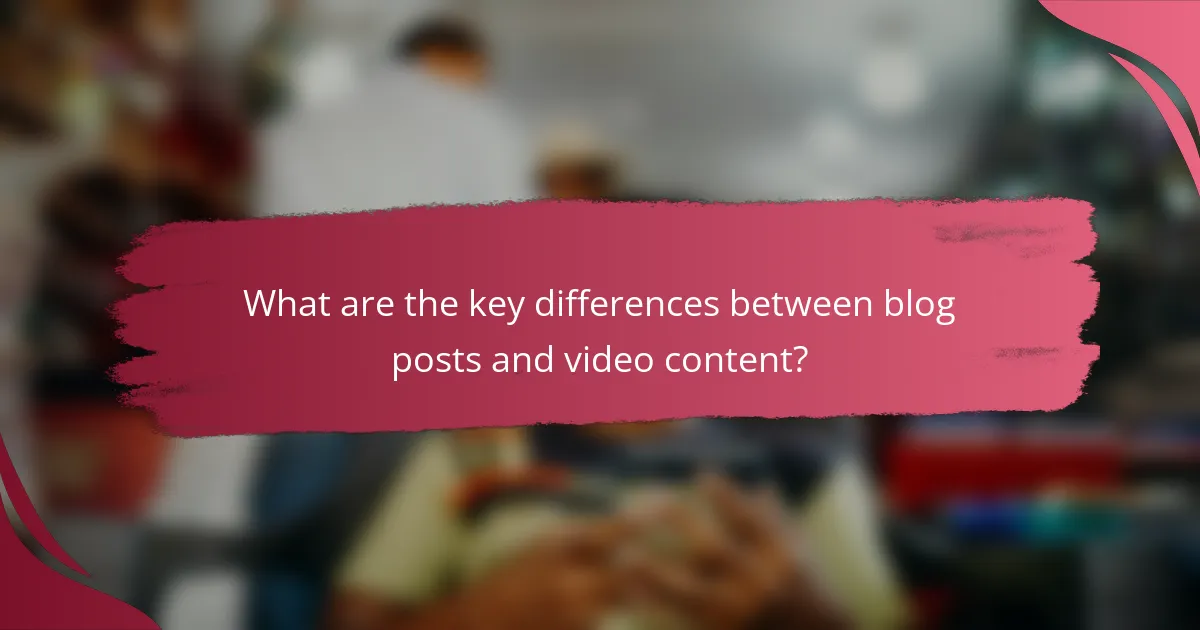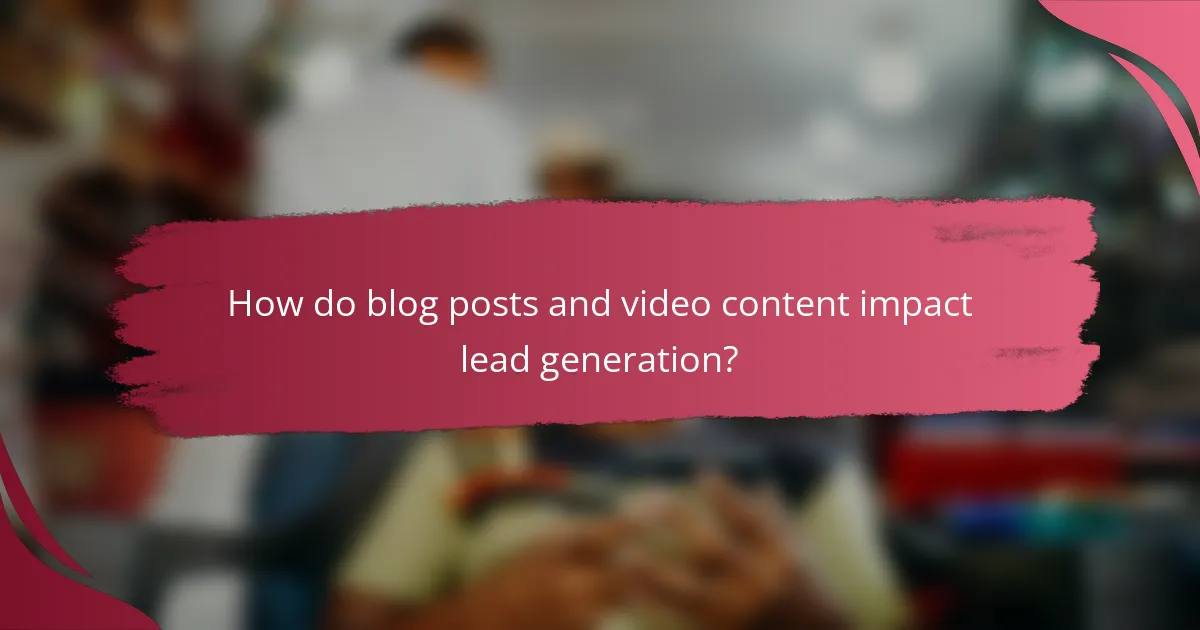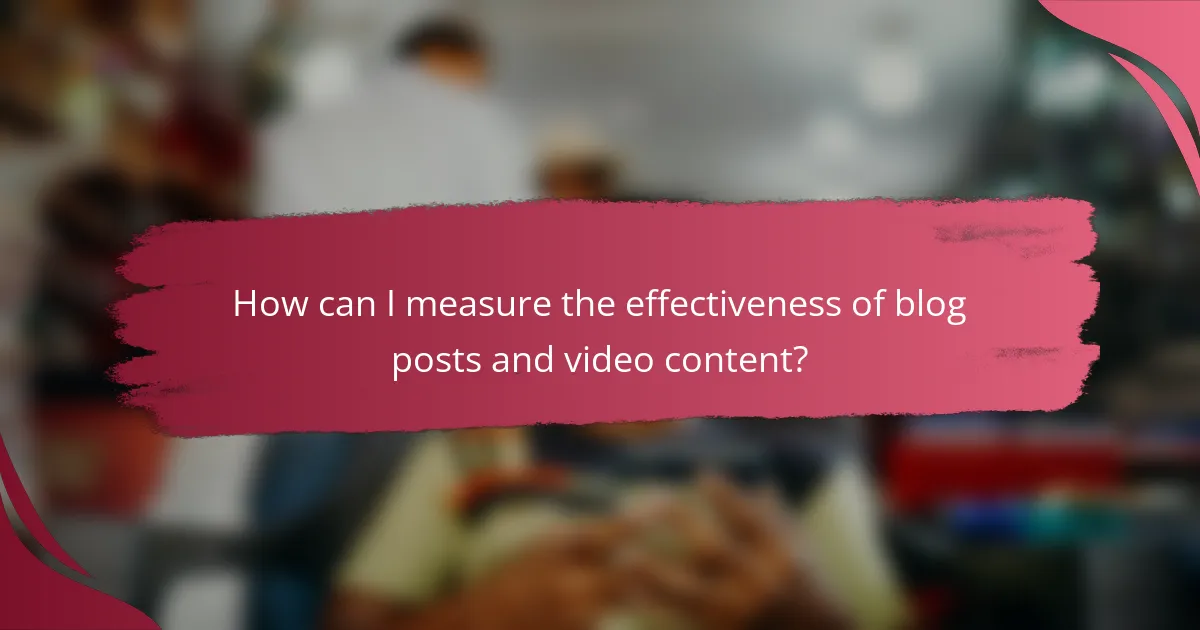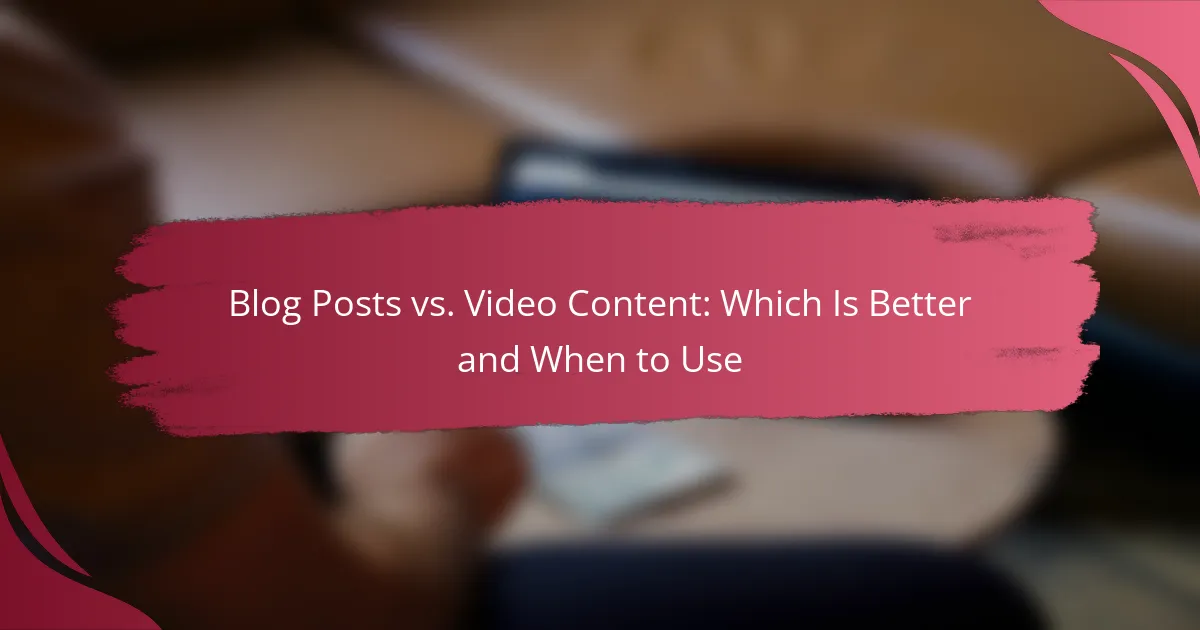When deciding between blog posts and video content, it’s essential to consider your marketing goals and audience engagement strategies. Blog posts are effective for delivering in-depth information and driving organic traffic, while video content shines in creating emotional connections and enhancing user engagement. Understanding when to use each format can significantly impact your content’s effectiveness and reach.

Which content format is more effective in the UK?
In the UK, the effectiveness of blog posts versus video content largely depends on the goals of your marketing strategy. Blog posts are typically better for driving organic traffic, while video content excels in enhancing user engagement.
Blog posts drive organic traffic
Blog posts are a powerful tool for attracting organic traffic through search engines. They can be optimized for SEO, allowing them to rank for relevant keywords and phrases, which can lead to increased visibility and site visits.
Consider creating content that answers common questions or addresses specific pain points of your target audience. For instance, a well-researched article on “best practices for digital marketing in the UK” can attract readers searching for that information.
To maximize the effectiveness of your blog posts, focus on quality content, use appropriate headings, and incorporate internal and external links. Regularly updating your blog can also improve its search engine ranking over time.
Video content enhances engagement
Video content significantly boosts user engagement by providing a dynamic and visually appealing way to convey information. Viewers are more likely to share videos, which can expand your reach and increase brand awareness.
For example, a short tutorial or product demonstration can capture attention more effectively than text alone. Engaging storytelling in videos can lead to higher retention rates, keeping viewers interested for longer periods.
To effectively use video content, ensure it is high-quality and relevant to your audience. Platforms like YouTube and social media channels can be excellent venues for sharing your videos, but always consider the specific preferences of your target demographic in the UK.

When should I use blog posts?
Blog posts are ideal for conveying in-depth information and engaging readers through written content. They serve well when you need to elaborate on topics, share insights, or provide detailed guides.
For detailed information sharing
Blog posts excel at delivering comprehensive information on a subject. They allow for thorough explanations, examples, and references that can help readers understand complex topics. For instance, a blog post can break down a technical process into manageable steps, making it easier for the audience to follow.
Consider using blog posts when you have a lot of content to cover or when the topic requires nuanced discussion. This format is particularly useful for tutorials, case studies, or analyses where depth is essential.
To improve SEO rankings
Blog posts can significantly enhance your website’s SEO rankings by incorporating relevant keywords and providing valuable content that attracts organic traffic. Search engines favor fresh, informative content, and regularly updated blogs can help maintain visibility.
To optimize your blog for SEO, focus on using targeted keywords naturally within your content, include internal and external links, and ensure your posts are well-structured with headings and subheadings. Aim for posts that are at least 1,000 words to increase the chances of ranking higher in search results.

When should I use video content?
Video content is best used when you want to engage your audience visually and emotionally, making it ideal for storytelling and product demonstrations. Consider using video when your message benefits from dynamic visuals or when you aim to create a deeper connection with your audience.
For storytelling and brand connection
Video is a powerful medium for storytelling, allowing brands to convey their values and narratives in a compelling way. By using visuals, sound, and motion, you can evoke emotions and create a memorable experience that resonates with viewers.
When crafting a brand story, aim for authenticity and relatability. Short videos, typically ranging from one to three minutes, can effectively capture attention and communicate your message without overwhelming the audience.
To demonstrate products visually
Using video for product demonstrations can significantly enhance understanding and interest. Visuals allow potential customers to see how a product works, highlighting its features and benefits in real-time.
Consider creating tutorial videos or unboxing experiences that last between two to five minutes. These formats help clarify complex features and can lead to higher conversion rates as customers feel more informed and confident in their purchasing decisions.

What are the key differences between blog posts and video content?
Blog posts and video content differ primarily in format and audience interaction. While blog posts are text-based and allow for in-depth exploration of topics, videos offer a dynamic visual experience that can enhance engagement.
Length and format variations
Blog posts typically range from 500 to 2,000 words, allowing for detailed explanations and comprehensive coverage of subjects. In contrast, video content often lasts from a few seconds to several minutes, with most effective videos falling between 1 to 5 minutes for optimal viewer retention.
When considering format, blog posts can include images, infographics, and links for additional context, while videos can incorporate animations, voiceovers, and music to create a more immersive experience. Choose the format based on the complexity of the subject and the preferences of your target audience.
Audience engagement levels
Video content generally achieves higher engagement levels compared to blog posts. Viewers are often more likely to share videos, leading to increased reach and visibility. Studies suggest that video content can increase engagement rates by a significant margin, often exceeding 50% compared to text-based formats.
However, blog posts can foster deeper understanding and retention of information through detailed explanations and the ability to revisit content at one’s own pace. Consider your audience’s preferences; if they favor quick, visual content, videos may be more effective, while those seeking in-depth analysis may prefer blog posts.

How do blog posts and video content impact lead generation?
Blog posts and video content both play significant roles in lead generation, but they do so in different ways. Blog posts primarily provide detailed information that nurtures leads, while video content can enhance engagement and boost conversion rates.
Blog posts nurture leads through information
Blog posts serve as a valuable resource for potential leads by offering in-depth information on specific topics. They help establish authority and trust, which are crucial for nurturing leads through the sales funnel. For instance, a well-researched article on industry trends can attract readers and encourage them to subscribe for more insights.
To maximize the effectiveness of blog posts, focus on creating high-quality content that addresses common pain points. Use clear headings, bullet points, and visuals to enhance readability. Aim for posts that are at least 1,000 words long, as longer content tends to perform better in search rankings.
Video content boosts conversion rates
Video content is highly effective at capturing attention and driving conversions. Studies show that viewers are more likely to engage with video content, which can lead to higher conversion rates compared to text-based content. For example, product demonstration videos can significantly increase purchase intent among viewers.
When using video for lead generation, keep videos concise—ideally under two minutes—to maintain viewer interest. Incorporate clear calls to action within the video to guide viewers toward the next steps, such as signing up for a newsletter or making a purchase. Additionally, consider using platforms like YouTube or social media to reach a broader audience.

What factors should I consider when choosing between blog posts and video?
When deciding between blog posts and video content, consider your target audience’s preferences, your content goals, and the resources available for production. Each format has distinct advantages and can serve different purposes depending on these factors.
Target audience preferences
Your audience’s preferences play a crucial role in determining whether to use blog posts or video. For instance, younger demographics often favor video content, as it is more engaging and easier to consume on mobile devices. In contrast, professionals seeking in-depth information may prefer blog posts for their ability to provide detailed analysis and references.
Conducting surveys or analyzing engagement metrics can help you understand what format resonates more with your audience. If your audience frequently shares video content on social media, it may indicate a preference for that medium.
Content goals and objectives
Define your content goals clearly to choose the right format. If your objective is to educate or inform, blog posts can offer comprehensive insights and allow for easy linking to additional resources. Conversely, if you aim to entertain or demonstrate a product, video can capture attention quickly and convey emotions effectively.
Consider the complexity of the information being shared. For straightforward topics, a short video may suffice, while more complex subjects might require the depth that a blog post can provide. Align your content format with your overall marketing strategy to maximize impact.

How can I measure the effectiveness of blog posts and video content?
To measure the effectiveness of blog posts and video content, focus on key performance indicators (KPIs) that reflect audience engagement and conversion. For blogs, consider metrics like page views and time on page, while for videos, look at views and watch time.
Analytics tools for blog performance
Analytics tools such as Google Analytics provide insights into blog performance by tracking user behavior. Key metrics include organic traffic, bounce rate, and average session duration. These indicators help you understand how well your content attracts and retains readers.
Additionally, tools like SEMrush or Ahrefs can analyze keyword performance and backlinks, offering a broader view of your blog’s reach. Regularly reviewing these metrics can guide content strategy and improve SEO efforts.
Video engagement metrics
For video content, engagement metrics are crucial for assessing performance. Key metrics include view count, average view duration, and audience retention rate. These figures help you determine how effectively your video captures and maintains viewer interest.
Platforms like YouTube and Vimeo provide detailed analytics dashboards that track these metrics. Monitoring engagement can inform future video topics and formats, ensuring you create content that resonates with your audience.

What are emerging trends in content marketing?
Emerging trends in content marketing include the rise of short-form video and interactive content, both of which engage audiences more effectively than traditional formats. These trends reflect changing consumer preferences and the need for brands to adapt their strategies to maintain relevance.
Short-form video popularity
Short-form video has gained immense popularity, especially on platforms like TikTok and Instagram Reels, where users prefer quick, engaging content. Brands can leverage this trend by creating bite-sized videos that convey messages succinctly, often under a minute.
To capitalize on this trend, consider focusing on storytelling and authenticity. Use catchy visuals and relatable themes to capture attention quickly. Aim for videos that are easily shareable, as this can significantly increase reach and engagement.
Interactive content growth
Interactive content, such as quizzes, polls, and augmented reality experiences, is increasingly favored by consumers who seek engagement rather than passive consumption. This type of content encourages participation and can lead to higher retention rates.
When implementing interactive content, ensure it aligns with your brand message and provides value to your audience. For example, a quiz that helps users identify their skincare type can drive engagement while promoting relevant products. Keep the experience user-friendly to avoid frustration and maximize participation.
